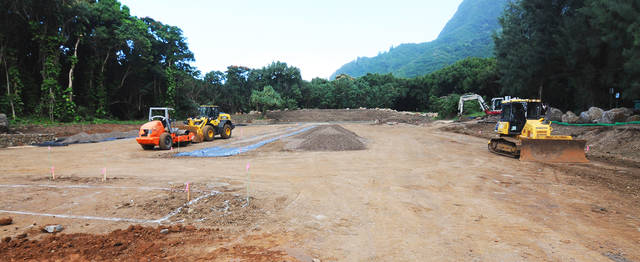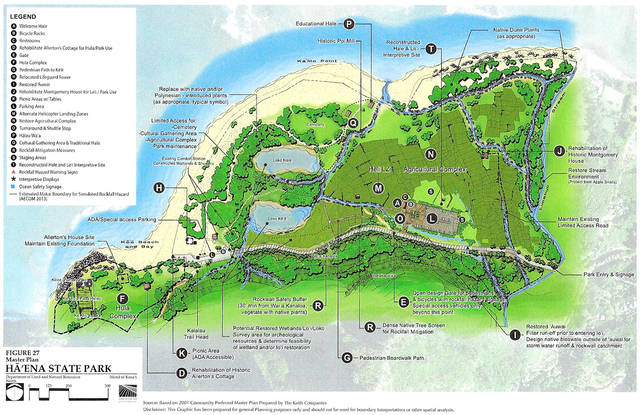Haena park opening nears
State park officials have set March 30 as the projected completion date for the total reconstruction of public facilities at Haena State Park.
State park officials have set March 30 as the projected completion date for the total reconstruction of public facilities at Haena State Park.
This development comes after months of addressing storm-related damage on Kuhio Highway and within the park itself and taking that opportunity to push through a full rebuild that will reduce the number of visitors by half and help native plants and animals to thrive there.
Unfortunately, it may be several more months into 2019 before the public can legally enter the reconceived Haena park because Kuhio Highway — the only access to the park — is closed indefinitely for repair after those same devastating April storms. The park will only reopen to people who live in the Hanalei-Haena area until the Kuhio Highway reconstruction is complete, officials say.
After the park is fully reopened, the number of people who can go there per day will drop from about 2,000 who visited daily before the April storms to about 900.
Details of the construction and planning were assembled by The Garden Island from interviews, documents and other materials late last week and over this past weekend. The estimated cost of the park modifications is about $2 million, according to Department of Land and Natural Resources.
It is all part of Kauai’s first deliberative plan to reduce tourist volumes at one of the island’s most revered destinations.
The goal is to balance the needs of the land and culture to remain comparatively undisturbed and to keep the tourist presence from adversely impacting the landscape and crowding out local people trying to get to sites that have special meaning — spiritual and otherwise.
Nearly 20 years of effort had already gone into formulating a new master plan for Haena park before the storms came. It was previously assumed that budget and other constraints would prevent full implementation of the park plan for several years. But the storm-related highway closure and sudden availability of government recovery funding changed that outlook entirely and the state Department of Land and Natural Resources has moved ahead quickly on several fronts.
When the park is finally accessible to the general public, with current estimates of June at the earliest, but more likely several months later — here are some of the changes that will be most noticeable:
• The parking lot is being entirely rebuilt and will have an absolute limit of 100 spaces. No parking will be permitted on the highway. More aggressive no parking sign placement and enforcement will place strict limits on the number of visitors who can drive into the park.
• At the same time, the plan ensures that local residents can have reasonably unfettered access to the park, with no entry fees, free spaces in the lot and no need for advance reservations. A driver’s licenses or state ID card will be serve as identification for anyone using the spaces reserved for local residents.
• All non-resident visitors will be required to get online-issued passes to enter Haena State Park. Initially, the cost will be $1 per person or $5 per car, but rule-making efforts are envisioned to triple those fees — or more — to create as significant a maintenance fund as possible through charging tourists.
• Parking at the end of Kuhio Highway inside the park immediately adjacent to the lifeguard tower —which has been the parking configuration for generations — will be closed and placed largely off limits because the area is prone to potentially deadly rock slides. All parking in the park will be in the central lot.
• The lot will be served by a shuttle, which visitors will be encouraged to use, but that will also be available to residents as well. Planning for the shuttle operation is proceeding independently, as DLNR lacks the power and resources to undertake such a service itself.
• Newly developed paths and a boardwalk path will lead visitors from the parking lot to Ke‘e Beach, limiting damage to vegetation and animal life. Loi and other agricultural activities will operate continuously within the park.
• Four new staff positions — a park manager and three rangers — will police the park, ensuring that anyone camping on the Napali Coast has a permit to do so and monitoring camper activities. They will also be responsible for overall park security.
• Overnight parking by camping permit holders will be prohibited and campers will be encouraged to use the shuttle or have friends drop them off. Entry to the Kalalau Trail will not resume until Kuhio Highway completely reopens, so hikers of all types will have to wait for that project to be finished.
Alan Carpenter, the DLNR official charged with implementing the Haena park plan, said he is acutely aware that the new system will represent marked changes for everyone who uses the park — visitor or resident.
Although Carpenter appreciates the opportunity created by the extended closure of Kuhio Highway, he believes a “soft opening” of the park, in which only residents and people with special county-issued passes can go there, will create a laboratory to perfect the change the broader public will eventually experience.
Access will be limited to people who can prove they reside between Hanalei and Ke‘e Beach or individuals who receive special permits to perform work or conduct other authorized business in the closure zone. It is the same restriction as has applied under a series of emergency orders signed by former Mayor Bernard Carvalho Jr. and current Mayor Derek Kawakami.
“If we do this perfectly, I’m not going to hear any complaints,” Carpenter said of the plan — especially concerning reservations for visiting tourists. “If we do it only well, then the people we’ll hear from are tourists.”
“We’re trying to solve a problem that’s been affecting this local, rural community for far too long, but there are going to be some bumps along the road. We obviously aren’t selling tickets now. When we get open, there will be a very short advance purchase period at the beginning.”
That means, he said, that parks officials will have to work very hard — and fast — to spread the word among visitors and local people alike that the park is open again, and what the restrictions are.
“We’re going to adjust as we go along. This is adaptive management,” he said, “and that requires some uncertainty.”
DLNR lacks authority to take action against illegal parking on Kuhio Highway, so state Rep. Nadine Nakamura, who formed an ad hoc transportation committee with locals, officials and other stakeholders last year, plans to reintroduce a bill that enables parking fines to be raised from $35 to $150.
Among visitor officials, there is broad recognition that a $35 parking fine is insufficient to deter someone who has spent thousands of dollars on a Kauai vacation from parking illegally and paying a small fine. Parking in many major cities can cost $40 an hour, so a $35 fine to park illegally at one of the world’s iconic sites is worth the price of admission.
Nakamura said plans are under discussion to provide for tow-away parking enforcement on Kuhio Highway throughout Haena so the limitations on parking and access at the park will not simply result in hundreds of rental cars littering highway shoulders throughout the community.
Part of the problem up until now is that existing state law gives no share of parking fine money to local law enforcement agencies that issue the tickets.
The bill Nakamura plans to offer would change that so that police agencies could, for example, hire civilian parking enforcement officers. Existing law, she said, permits such officers but provides no way to pay their salaries.
“The tricky thing about the North Shore is it’s like a puzzle,” Nakamura said. “We have to put up the signs and it’s fines or tow-away. The fine might go up to $200. But there have to be places where limited street parking could be permitted for surfers and local fishermen.
“A third part is the shuttle. The idea is to discourage visitors from going out there in single occupancy vehicles. Then the idea is now to get people on the shuttle and whether they start their trips in Kilauea, Princeville or elsewhere.”
Nakamura conceded that her effort to push through the legislation last year failed. That’s not uncommon for new bills that seek to make significant change, she said.
“It’s a complicated situation. We’re trying to think outside of the box,” she said. “Often, to get it right, you have to go through this process multiple times.”



